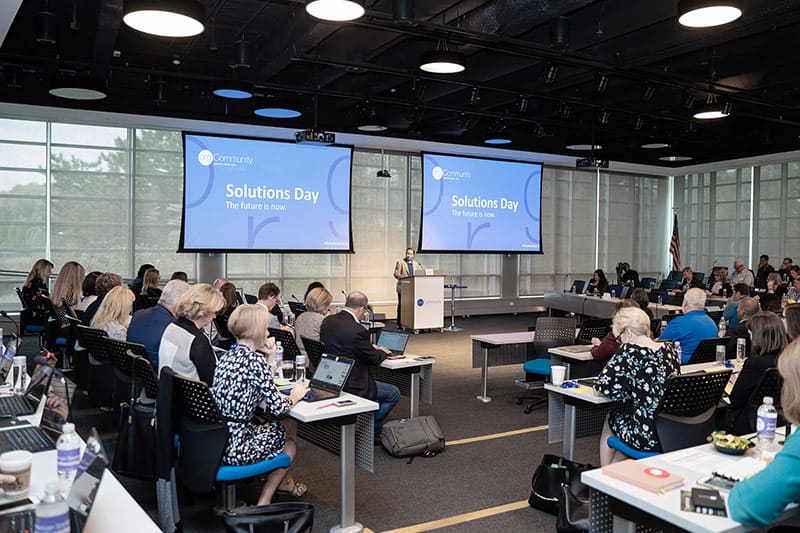Celebrating Associations is a weekly blog produced by .orgCommunity, celebrating the achievements of associations and the great impact on the industries they serve.
 Association and History: An independent, nonprofit organization, The Joint Commission accreditation and certification is recognized nationwide as a symbol of quality that reflects an organization’s commitment to meeting certain performance standards. TJC seeks to continuously improve health care for the public, in collaboration with other stakeholders, by evaluating health care organizations and inspiring them to excel in providing safe and effective care of the highest quality and value.
Association and History: An independent, nonprofit organization, The Joint Commission accreditation and certification is recognized nationwide as a symbol of quality that reflects an organization’s commitment to meeting certain performance standards. TJC seeks to continuously improve health care for the public, in collaboration with other stakeholders, by evaluating health care organizations and inspiring them to excel in providing safe and effective care of the highest quality and value.
Founded in 1951, TJC is the nation’s oldest and largest standards-setting and accrediting body in health care. TJC evaluates and accredits nearly 21,000 health care organizations and programs in the United States. To earn and maintain TJC’s Gold Seal of Approval®, an organization undergoes an on-site survey by a Joint Commission survey team at least every three years. (Laboratories are surveyed every two years.)
TJC is governed by a 32-member Board of Commissioners that includes: physicians, administrators, nurses, employers, quality experts, a consumer advocate and educators. TJC employs approximately 1,000 people in its surveyor force, at its central office in Oakbrook Terrace, Ill., and at an office in Washington, D.C.
We’re celebrating TJC because … of its Speak Up™ patient health and awareness campaign, which recently added “reduce admissions” and “safe use of antibiotics” to its growing list of more than 20 topics. According to a 2014 survey, 86 percent of the approximately 1,600 respondents want TJC to sponsor more campaigns; 80 percent are very likely or somewhat likely to recommend the program to a colleague; 67 percent use Speak Up information in patient educational materials; 62 percent say Speak Up empowers and educates patients and makes them a partner in their care; and nearly 50 percent use the information for staff education.
We’ll learn more in an interview with Dawn Glossa, MPA, TJC’s director of corporate communications.
Q: What inspired the launch of the Speak Up™ patient safety awareness campaign?
A: In March 2002, TJC launched its Speak Up™ patient safety program. Over time, the program has expanded to more than 40 countries and features infographics, animated videos, brochures and posters. The program urges patients to:
- Speak up if you have questions or concerns.
- Pay attention to the care you get.
- Educate yourself about your illness.
- Ask a trusted family member or friend to be your advocate (advisor or supporter).
- Know what medicines you take and why you take them.
- Use a health care organization that has been carefully checked out.
- Participate in all decisions about your treatment.
Speak Up was created to support our mission in providing safe care for everyone.

Q: What is the purpose of the campaign?
A: Speak Up information is used for public service announcements, websites, community newsletters, health fairs, closed circuit patient education television, and staff orientation. The popular animated videos have been downloaded by organizations in more than 70 countries. In a survey conducted in 2014:
- More than 67 percent use Speak Up information in patient educational materials.
- 62 percent said Speak Up empowers and educates patients and makes them a partner in their care.
- Nearly 50 percent use the information for staff education.
Q: How often are new topics added? How are they determined?
A: New topics are determined by surveying customers on what issues are “keeping them up at night” along with paying close attention to public health issues that are bubbling up. We chose three topics annually based on this data.
Q: What campaign features are most popular (Infographics? Animated videos? Brochures/posters?)
A: In 2015, we introduced the infographic to replace the brochure and posters—it has been very popular. Our videos are still the most favorite.
Q: How is the campaign’s success measured?
A: We don’t have a set measure for success, but rather focus on how many folks we are reaching. We are in 40 countries in print and 70 in video, and produce Speak Up in English and Spanish. Many others have translated them in their native language.
Q: Did TJC anticipate this type of impact? Do these results exceed expectations, or does this just prove the campaign is on target?
A: Not at all what we expected. The growth of the program surprised us, but we are thrilled that it is being used with such reach. This growth shows that patient safety is an important topic.
Q: Who is the target audience?
A: Targeted audiences include anyone who has an interaction with one of our accredited customers. We accredit: hospitals, behavioral health organizations (including foster care, rehab, therapy), rehabilitation hospitals, ambulatory care organizations, nursing care centers, and home health agencies.
Q: What is the staff vs. volunteer involvement in shaping this campaign?
A: We rely on our internal experts, which include: physicians, nurses, therapists, and other health care professionals. We also work closely with medical specialty societies for content expertise.
Q: Explain what impacted the design and technical choices for the videos, infographics, etc.
A: The goal of Speak Up was to assure that it was appealing to all audiences. The video format is engaging and easy for all ages and education levels to understand. The infographic adds a modern way to portray the information clearly.
Q: What is the annual campaign budget?
A: We spend approximately $20,000 in production costs each year, with internal staff talent for development.
Q: Any parting thoughts?
A: Sometimes looking at your mission can also allow you to give your membership an extra piece of value. Our Speak Up program allows us and our customers to improve patient safety.
Share YOUR Story: What great things is your association doing for its industry or for its operations? Contact heather@orgcommunity.com for details about submitting a story or to be interviewed.
Not yet a member of .orgCommunity? Invest in yourself and your organization by joining the .orgCommunity, which nurtures innovation in leaders through peer-to-peer interactions and programming.


